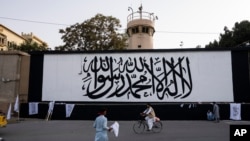Recent assessments by U.S. military officials are raising questions about Afghanistan’s Taliban rulers and what they are willing to do to keep the al-Qaida terror group in check.
As part of the February 2020 Doha Agreement with the United States that paved the way for the U.S. withdrawal from Afghanistan, the Taliban agreed to make sure Afghanistan would never again be used as a launchpad for terror attacks against the West.
But the assessments by U.S. Central Command, which oversees U.S. military forces in the Middle East and South Asia, and shared with the Department of Defense Office of Inspector General indicate that while that pledge is holding for now, the Taliban may be ready to consider a change.
"The Taliban will likely loosen these restrictions over the next 12 to 24 months, allowing al-Qaida greater freedom of movement and the ability to train, travel, and potentially re-establish an external operations capability," according to an inspector general report released Tuesday.
CENTCOM’s assessment does not explain why the Taliban appear willing to let al-Qaida operate more freely, though the inspector general report points to military intelligence estimates that note both al-Qaida and its regional affiliate, al-Qaida in the Indian subcontinent (AQIS), certainly aspire to attack the U.S. and U.S. targets.
However, the U.S. Defense Intelligence Agency has also said that al-Qaida’s progress has been stunted despite the lack of a U.S. counterterrorism presence in Afghanistan.
"Al-Qaida has had some problems with reconstitution, leadership and, to a degree, I think the Taliban have held to their word about not allowing al-Qaida to rejuvenate," DIA Director Lieutenant General Scott Berrier told lawmakers in Washington on May 10.
"It’s something that we watch very, very carefully," he said, adding that it would likely take more than a year for al-Qaida to be able to launch or direct attacks against the U.S.
Recent intelligence estimates from the United States and from other countries put the number of al-Qaida followers in Afghanistan at several hundred, including al-Qaida leader Ayman al-Zawahiri.
A United Nations report issued this past February, however, cautioned that, "some of its [al-Qaida's] closest sympathizers within the Taliban now occupy senior positions in the new de facto Afghan administration."
Intelligence shared by U.N. member states indicates AQIS has up to 400 fighters in Afghanistan spread across at least six provinces, though the recent U.S. assessments put the number at about half that.
Taliban officials rarely speak publicly about al-Qaida, likely given the close relationship between the two groups. However, U.S. military and diplomatic officials have said that, at least until now, the Taliban have taken steps to make good on their counterterrorism commitments.
Taliban officials have been willing to publicly discuss the Islamic State affiliate in Afghanistan, also known as IS-Khorasan Province or ISIS-K. And in a statement Tuesday, Taliban Foreign Minister Mawlawi Amir Khan Muttaqi assured the U.N. Mission in Afghanistan that that IS-Khorasan has been eradicated.
Islamic State
U.S. military and intelligence officials, though, caution that contrary to the Taliban’s assertions, IS-Khorasan may be poised to expand its operations in Afghanistan and beyond.
DIA officials told the Pentagon Inspector General that IS-Khorasan likely has about 2,000 fighters across Afghanistan and that the group could direct an attack in the West within the next year if the terror group so chooses.
The DIA also warned IS-Khorasan has increased its efforts to recruit inside Afghanistan and that it had made a concerted effort to recruit from Afghanistan’s neighbors.
"Since January ISIS-K has been publishing media in Central Asian languages to reach ethnic minorities in the region," the report said. "[It] aims to inspire supporters in these regions to travel to Afghanistan or conduct attacks where they are located, potentially against Western personnel and interests."
Western intelligence and humanitarian officials warned VOA last year that IS-Khorasan was busy laying the groundwork to expand its reach into Central Asia.
"They are building local infrastructure for the recruitment, logistics, economic support, economic infrastructure to support that," one humanitarian official who asked not to be named for fear they might be target, told VOA last July.
The focus was on "more quality and less numbers," the official said.
No counterterror strikes
The U.S. has not conducted any counterterrorism strikes in Afghanistan since the last U.S. forces left the country last year, with the Pentagon saying on Tuesday airstrikes have not yet been necessary.
"We haven't felt the need to do that," Pentagon press secretary John Kirby told reporters.
"We’re not just sitting idly by," he added. "We’re working continually on making sure we have strong over-the-horizon counterterrorism capabilities."
Kirby also said the Pentagon is watching the situation with the Taliban and al-Qaida as closely as it can.
"We've long said that we're going to judge the Taliban by what they do, not what they say," Kirby said in response to a question from VOA. "Nobody wants to see al-Qaida regain any kind of tangible footprint in Afghanistan or any ability to plan or attack outside the region."
According to the Defense Department Inspector General report, Pentagon financial officials estimate the U.S. will spend about $19.5 billion in fiscal 2022 to support its counterterrorism operations in Afghanistan out of a headquarters in Doha.









